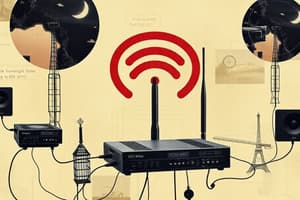Podcast
Questions and Answers
Which frequency band is utilized by the WiMax long-range wireless standard?
Which frequency band is utilized by the WiMax long-range wireless standard?
- 3.65 GHz (correct)
- 2.4 GHz
- 5 GHz
- 900 MHz
What is a potential consequence of excessively increasing an access point's power?
What is a potential consequence of excessively increasing an access point's power?
- Interference with other wireless devices (correct)
- Extended wireless range with no issues
- Reduction in power consumption
- Improved connection speed
What is the primary characteristic of unbounded media used in wireless networks?
What is the primary characteristic of unbounded media used in wireless networks?
- Signals travel further compared to bounded media.
- Signals are sent through the air without physical confinement. (correct)
- Signals have a higher likelihood of interference.
- Signals are encased in a protective sheath.
What are the two most common frequency ranges used in wireless networks in the United States?
What are the two most common frequency ranges used in wireless networks in the United States?
How does the wave frequency affect the data transfer rate in wireless networks?
How does the wave frequency affect the data transfer rate in wireless networks?
What issue might arise if a wireless network is operating at 2.4 GHz while a microwave is in use?
What issue might arise if a wireless network is operating at 2.4 GHz while a microwave is in use?
What does changing the channel in a wireless network accomplish?
What does changing the channel in a wireless network accomplish?
What limitation exists with the 2.4 GHz frequency channels?
What limitation exists with the 2.4 GHz frequency channels?
What is a consequence of using unlicensed frequency ranges for wireless networks?
What is a consequence of using unlicensed frequency ranges for wireless networks?
Which feature of wireless routers helps mitigate the issue of interference?
Which feature of wireless routers helps mitigate the issue of interference?
What are the only non-overlapping channels in the 2.4 GHz range?
What are the only non-overlapping channels in the 2.4 GHz range?
Which standard operates in the 5 GHz range and provides a maximum data rate of 54 Mbps?
Which standard operates in the 5 GHz range and provides a maximum data rate of 54 Mbps?
What is one advantage of the 802.11n standard over its predecessors?
What is one advantage of the 802.11n standard over its predecessors?
Which of the following features is introduced with the 802.11n standard?
Which of the following features is introduced with the 802.11n standard?
What does MU-MIMO enable compared to traditional MIMO?
What does MU-MIMO enable compared to traditional MIMO?
Which standard achieves a theoretical maximum speed of 14 Gbps?
Which standard achieves a theoretical maximum speed of 14 Gbps?
Which technology involves combining two non-overlapping channels to increase data transfer rates?
Which technology involves combining two non-overlapping channels to increase data transfer rates?
How many non-overlapping channels are available in the 5 GHz range?
How many non-overlapping channels are available in the 5 GHz range?
What does beamforming accomplish in wireless networking?
What does beamforming accomplish in wireless networking?
What is the maximum theoretical speed of the 802.11ac standard?
What is the maximum theoretical speed of the 802.11ac standard?
What is a significant limitation that affects the range of wireless signals indoors?
What is a significant limitation that affects the range of wireless signals indoors?
Which standard utilizes both MIMO and channel bonding to enhance performance?
Which standard utilizes both MIMO and channel bonding to enhance performance?
To connect two buildings that are a short distance apart using wireless technology, which option is recommended?
To connect two buildings that are a short distance apart using wireless technology, which option is recommended?
Flashcards are hidden until you start studying
Study Notes
Wireless Networking Overview
- Wireless networks use radio waves to transmit data.
- Radio waves are an unbounded medium, allowing for more flexibility compared to cables.
- Common radio frequencies used in the United States are regulated by the FCC.
- 2.4 GHz: Wider waves, longer range, slower data transfer.
- 5 GHz: Thinner waves, shorter range, faster data transfer.
- These frequencies are unlicensed, allowing for interference from other devices (e.g., microwaves operating at 2.45 GHz).
- Changing channels allows for tuning the frequency to reduce interference.
Wireless Standards
- IEEE 802.11 standards define how wireless frequencies are used.
- 802.11a: Operates at 5 GHz, transmits data at 54 Mbps, range up to 100 feet.
- 802.11b: Operates at 2.4 GHz, transmits data at 11 Mbps, range up to 150 feet.
- 802.11g: Operates at 2.4 GHz, combines the best of 802.11a and 802.11b, transmits data at 54 Mbps, range up to 150 feet.
- 802.11n: Transmits data at 600 Mbps, range up to 300 feet, supports both 2.4 GHz and 5 GHz frequencies, introduces MIMO.
- MIMO (Multiple Input, Multiple Output): Uses additional transmit and receive radios for faster data transfer.
- MU-MIMO (Multi-User MIMO): Allows antennas to divide streams between multiple devices, using beamforming to focus transmissions.
- Channel Bonding: Combining non-overlapping channels to increase speed.
- 802.11ac (Wi-Fi 5): Uses MIMO and channel bonding to achieve speeds up to 2.6 Gbps, range up to 300 feet.
- 802.11ax (Wi-Fi 6): Operates at 5 GHz, further enhances MIMO, channel bonding, and other technologies to achieve theoretical speeds up to 14 Gbps, range up to 300 feet.
Long Range Wireless Networks
- For short distances, high-end wireless access points with special antennas can be used.
- For longer distances, licensed frequencies like 900 MHz or 3.65 GHz are required.
- WiMax operates at 3.65 GHz.
- Increasing the power of the access point can extend range but requires following FCC guidelines to avoid interference.
Studying That Suits You
Use AI to generate personalized quizzes and flashcards to suit your learning preferences.




